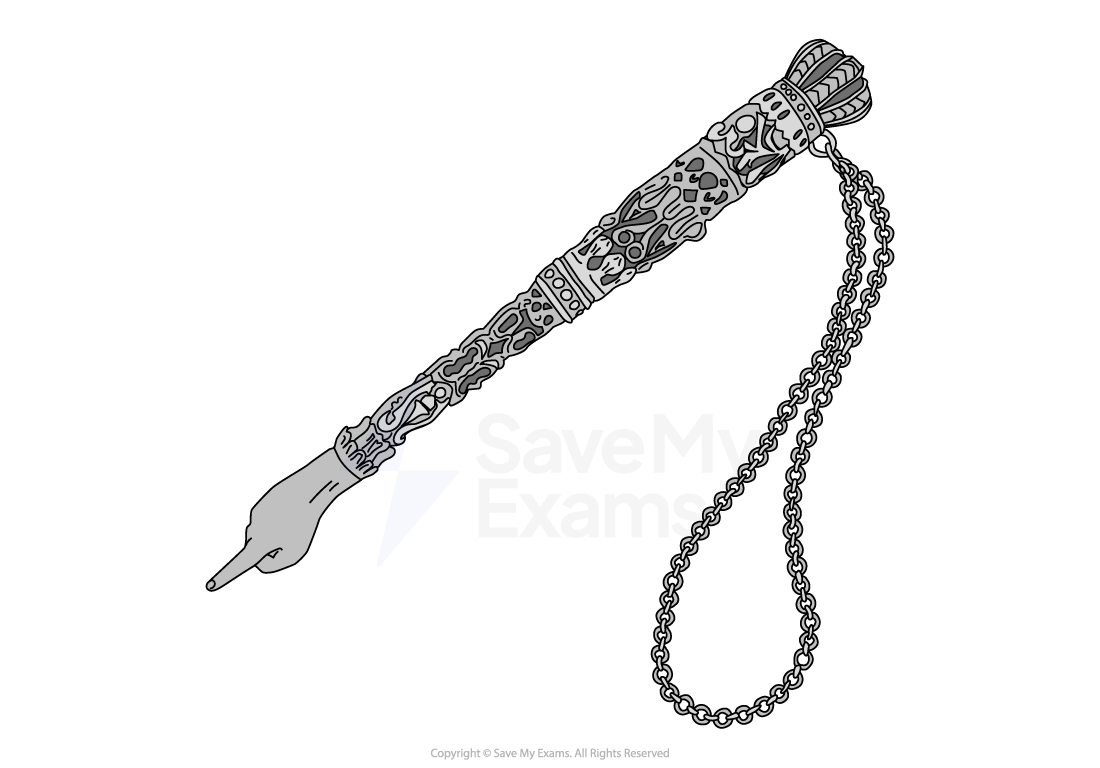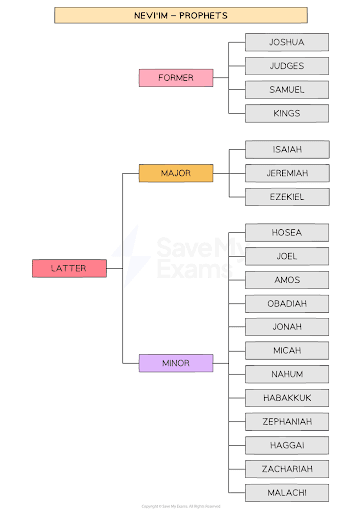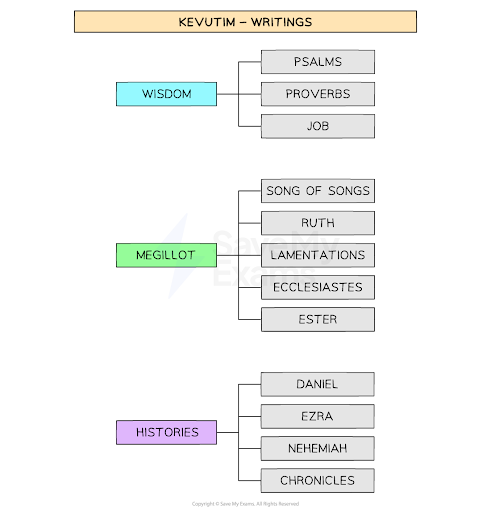Judaism: Daily Life (WJEC Eduqas GCSE Religious Studies): Revision Note
Exam code: C120
The Tenakh and Talmud in daily life
What are the Tenakh and the Talmud?
The Tenakh is the main sacred Jewish text and governs all aspects of Jewish life
The Old Testament in the Christian Bible is made up of the books of the Tenakh, although they appear in a different order
Often, the Tenakh is written TeNaKh; the capital letters are the initials of the different sets of books that it comprises
T for Torah, N for Nevi’im and K for Ketuvim

What is the Torah?
The Torah is the name given to the laws and teachings within Judaism
The Torah is the first five books of the Old Testament
Genesis
Exodus
Leviticus
Numbers
Deuteronomy
The Torah was given to Moses by God, and it contains the mitzvot, including the Ten Commandments
The Torah is always treated with great respect within Judaism
It is an honour to be asked to read from it at a service in the synagogue
No one is allowed to touch the Torah with their bare hands
Instead, a pointer called a yad is used to follow the words

The Torah is read aloud over the course of a year in Orthodox synagogues or over three years in Reform synagogues
When the Torah is carried through the synagogue, worshippers in the congregation bow as it passes them
What are the Nevi’im (prophets)?
The Nevi'im consists of eight books that trace Jewish history and expand on the laws given in the Torah
Each of the books is named after one of the eight prophets who are believed to have been chosen by God to encourage Jews to follow God’s laws
There are two sections to the Nevi’im
These are the former and the latter prophets
The former prophets talk about the history of the Israelites
The latter prophets contain the words of 15 prophets, including Isaiah

What are the Ketuvim (writings)?
The Ketuvim contains 11 books, including Psalms and Proverbs
Many of these books contain writings on philosophy

What is the Talmud?
Although the Torah is absolute and everlasting, some Jews look for new interpretations of its words to help them relate the teachings to today’s life
The Talmud helps with this, as it interprets the laws of the Torah and relates them to modern issues
The Talmud is a collection of teachings and discussions from early rabbis about the Torah and is split into two parts
The Mishnah was compiled by Rabbi Judah Ha’Nasi, who wrote down the oral law to avoid future misinterpretations. It explains how to apply and follow the mitzvot
The Mishnah includes lessons and quotations by scholars from first-century rabbis and their discussions about how the laws given in the written Torah could be adapted to suit new situations
The Gemara is a collection of discussions and comments relating to the Mishnah
There are two versions of the Talmud: the Jerusalem Talmud and the Babylonian Talmud
They differ in many ways apart from their places of origin and dates of compilation
How do Jews use the Tenakh and Talmud in their daily lives?
The Tenakh and the Talmud are used in Jewish worship
The Tenakh commands prayer and Sabbath rest, and the Talmud explains how and when to pray
They are also used in relation to dietary laws
The Tenakh lists clean and unclean animals (Leviticus 11), and the Talmud explains how to prepare and separate meat and dairy
Both are used to advise and support issues relating to family life
The Tenakh gives laws on marriage and respect for parents, and the Talmud discusses marriage contracts and raising children
The Tenakh and Talmud help Jews to live a moral life
The Tenakh teaches to love your neighbour (Leviticus 19:18), whereas the Talmud gives examples of fairness, charity and honesty in work
They both give helpful information about maintaining justice in Jewish life
The Tenakh provides moral rules, and the Talmud explains how to apply them in court and society
Both texts are important in the daily lives of Jews
They show Jews how to live according to God’s will
They help maintain Jewish identity and unity across the world
They provide moral guidance and spiritual discipline
Rabbis use them to make modern decisions (about medicine or technology)
Studying them is a form of worship and obedience to God
Dietary laws
What are kashrut laws?
Jewish laws regarding food are known as kashrut
The kashrut laws cover all of the rules relating to food, including:
The type of animals a Jewish person can eat
How the animals are prepared
The foods that are forbidden include:
Blood, certain fats and sinews
Flies and insects
Food preparation
These rules are contained within the mitzvot, mainly within the Books of Deuteronomy and Leviticus
Following the rules around food shows obedience and self-control
Food that is allowed is called kosher (meaning fitting or correct), and food that is not allowed is called treif
Examples of treif food include shellfish, pork products and food that has not been slaughtered correctly, known as shechitah
What are kashrut laws related to food?
There are strict rules that govern kosher laws, and these are based on scripture
Land animals must have cloven (split) hooves and must chew the cud, meaning that they must eat grass
Seafood must have fins and scales, so eating shellfish is not allowed
It is forbidden to eat birds of prey as they are not considered “clean” birds ( meaning birds that do not eat other animals), but poultry (chicken, etc.) is allowed
Meat and dairy cannot be eaten together

Keeping kosher in Britain
How do Jews keep kosher in Britain?
In big cities with large Jewish communities in the UK, there are kosher supermarkets, shops and restaurants catering to Jewish people
Often, these are located near synagogues
Even in smaller communities with fewer Jewish people, many major supermarkets have a kosher food section
Many food manufacturers produce ordinary foods to kosher standards
Also, some foods and drinks are labelled “parev” to show that they contain no meat or dairy
Some Jews avoid eating out at dinner parties and non-kosher restaurants and cafes
Some Reform and Liberal Jews are less strict about the rules when eating out or at friends’ homes
Many Jews may stick to vegetarian or vegan options when eating out, as all of these foods are parev
How is food prepared in Britain today?
Eating meat within Judaism is acceptable, and this is written in scripture
“Thou shalt slaughter of thy herd and of thy flock, which the Lord hath given thee, as I have commanded thee, and thou shalt eat within thy gates, after all the desire of thy soul” (Deuteronomy 12:21)
For meat to be consumed, it must be kosher
Meat is only considered kosher if it has been prepared according to Jewish dietary laws
Meat is also viewed as trefah if it has not been slaughtered correctly (the proper way is known as shechitah)
The person who can act as the slaughterer (shohet) must be proficient in the practice and be a religious Jew
Customarily, the shohet must receive written authorisation from a recognised rabbinical authority regarding his qualifications for the role
During the slaughtering process:
Animals must have their throats cut with a sharp knife by a shohet, a person trained to slaughter animals in a kosher way
Judaism forbids causing unnecessary pain to animals, so the throat is cut with a razor‐sharp knife, causing an immediate loss of consciousness and death
The blood must then be drained from the animal because the Book of Deuteronomy (12:23) forbids Jews to eat or drink blood
“But make sure that you do not partake of the blood; for the blood is the life, and you must not consume the life with the flesh” (Deuteronomy 12:23)
No animals that have died naturally can be eaten
It is forbidden to slaughter the parent with its young on the same day
“However, no animal from the herd or from the flock shall be slaughtered on the same day with its young” (Leviticus 22:28)
It is forbidden to eat animals that have been killed by other animals
This prohibition is taken to include other diseases or disorders that afflict the animal and cause it to die
“Ye shall not eat any flesh that is torn of beasts in the field” (Exodus 22:30)
The batte din, or the Jewish tribunal, regulates kosher butchers to ensure that kosher rules are maintained
Separation of milk and meat
The biblical text forbids cooking a mixture of milk and meat
Do not boil a kid in its mother’s milk” (Exodus 23:19)
Based on scripture, distinct rules have been developed that Jews must adhere to, including:
Not cooking meat and milk together (regardless of whether the result is eaten)
Not eating milk and meat together (regardless of whether it was cooked together)
Jews must therefore be careful about what they eat and how the food is prepared
Jews who follow these dietary rules cannot eat cheeseburgers, for example, because they mix meat with cheese (which is made from milk)
Often, this rule is extended further so that people wait up to six hours after eating meat before they eat dairy
It also means that all dairy products and the utensils used for serving them must be kept apart from meat products and utensils within the kitchen
Some Jewish kitchens have two separate counters for meat and milk to avoid mixing them

Worked Example
Explain two reasons why following dietary laws (kashrut) is important for many Jews
[5 marks]
Answer:
Following dietary laws is important because they are commandments from God in the Torah. Leviticus 11 lists clean and unclean animals, and by obeying these rules, Jews show respect and obedience to God’s will. Keeping kosher is therefore a way of living a holy life in accordance with the mitzvot (commandments).
It is also important because kashrut strengthens Jewish identity and community. When Jews eat only kosher food, especially during festivals or in shared meals, it reminds them of their faith and connects them to other Jews around the world. It also helps to maintain separation from non-Jewish practices, as part of being God’s chosen people [5 marks]
Examiner Tips and Tricks
You’ll need to use accurate Jewish vocabulary for top marks, such as:
Kosher — Foods that are permitted and prepared according to Jewish law
Treifah (Treyf) — Foods that are forbidden (e.g. pork, shellfish)
Kashrut — The Jewish dietary laws
Shechita — The method of slaughter that makes meat kosher
Parev — Foods that are neutral (neither milk nor meat)
Mitzvot — Commandments given by God
Tip: Always use one Hebrew term correctly in your answer — it can earn you a higher-level mark
Know what the Torah teaches:
Be ready to refer to the main biblical sources:
Leviticus 11: Lists clean and unclean animals
Exodus 23:19 / Deuteronomy 14:21: “Do not cook a young goat in its mother’s milk.” — Provides the basis for keeping meat and dairy separate
Tip: Quote briefly and explain. For example, “Leviticus 11 teaches Jews to eat only clean animals, showing obedience to God.”

Unlock more, it's free!
Did this page help you?